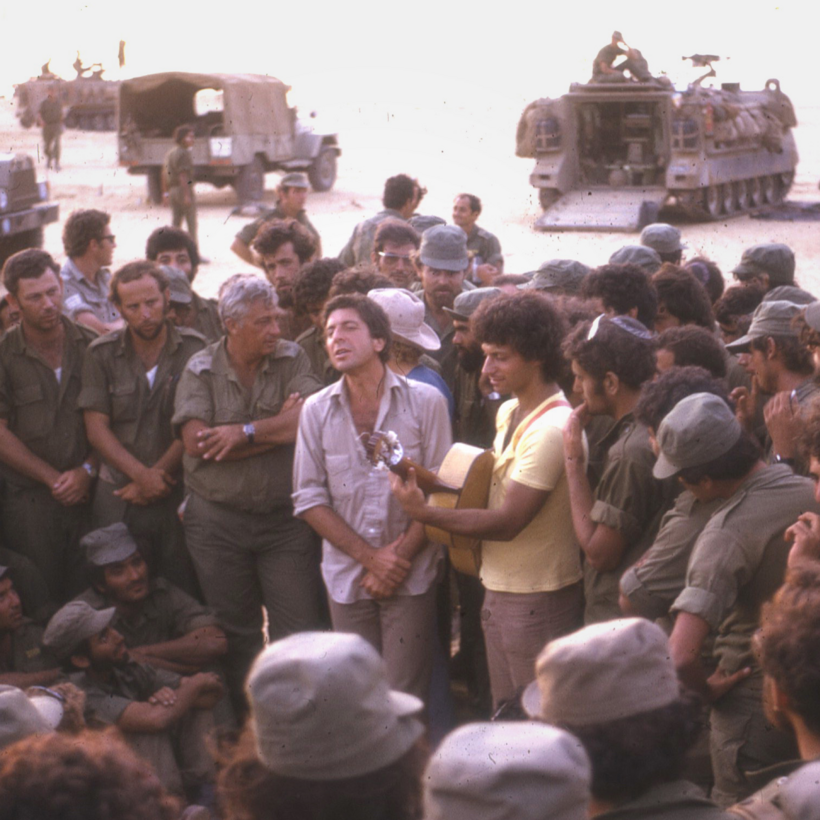In the fall of 2009 the “poet of rock,” the bard of Montreal and the Chelsea Hotel, landed in Tel Aviv. Leonard Cohen had emerged from a Zen monastery in California not long before to discover that a former manager had emptied his bank account.
He embarked on a concert tour after years of absence and discovered that he hadn’t faded into irrelevance but had, in fact, ascended to the heights of fame. On stages across North America and Europe that year, he fell on his 75-year-old knees night after night, surrendering theatrically to “the lord of song,” clutching his fedora to his chest in a pose of elegant gratitude. In Israel, a country whose population is roughly that of New York City, he drew 50,000 people.
If Cohen was surprised by the astonishing response to his presence in Tel Aviv, I was surprised to find that Israelis felt they knew him personally—that they shared an unforgettable experience, the significance of which was clear to them and to the singer and to no one else. This turned out to be true. It had happened 36 years earlier, at one of the darkest moments in Israel’s history.
Into the War Zone
In the second week of October 1973, the Israeli Army was in utter disarray, having mishandled surprise attacks by Egypt and Syria on Yom Kippur, a day of fasting and prayer that is the most solemn of the Jewish calendar. Fighting was desperate amid the basalt outcroppings of the Golan Heights in the North, and in the dunes along the Suez Canal in the South. A national illusion of invincibility was shattered, and thousands were dead. This was the Yom Kippur War.
At this hopeless moment, out of the smoke of battle, at the outer extremity of the Sinai front, strode … Leonard Cohen.
What on earth was he doing here? When I learned of this episode, it wasn’t clear. This was underground history, present in fractured human memories but never spelled out. Cohen almost never spoke about the war, a fact that seemed stranger and stranger to me the more I learned about how deep he’d gone into it, and how much he meant to the soldiers who were lucky enough to see him and survive to tell.
There were hints in his work: “Who by Fire,” for example, a sly riff on a medieval prayer from the Yom Kippur liturgy, which came out a few months after the cease-fire, and which has since traveled back into the synagogue, remarkably, as a kind of prayer itself. Or the classic “Lover Lover Lover,” which turned out to have been written at an Israeli air base between concerts for crews who were being decimated by Soviet surface-to-air-missile batteries, suggesting one explanation for the verse in which he expresses hope that his song will serve as a “shield against the enemy.”
At this hopeless moment, out of the smoke of battle, at the outer extremity of the Sinai front, strode … Leonard Cohen.
This was all very strange and seemed worth figuring out. I spent years doing that, first by clipping articles and collecting scraps of information, then by tracking down the former soldiers who’d encountered the singer at the most terrible and exhilarating moment of their lives, and ultimately by reading Cohen’s own remarkable and unpublished writing about the war, which I found—thanks to a stroke of luck and the generosity of Cohen’s family trust—in papers kept by the Cohen estate, on Wilshire Boulevard in Los Angeles, and by his Canadian publisher in a university library in Hamilton, Ontario.
The material recounted how a radio report on Israel’s crisis in 1973 offered the singer a way out of an acute crisis of his own; how he was picked up in a café by a few Israeli musicians and taken to the war in a Ford Falcon; how he found himself fascinated, moved, and rattled by what he saw; and how terrifying and unpredictable was the fate of his audience before and after every show.
What emerged wasn’t just a great moment in music history, or in Israeli history. Sometimes an artist and an event interact to generate a spark far bigger than either could individually: work that isn’t a mere memorial to whatever inspired it but an assertion of human creativity in the face of all inhuman events.
It isn’t necessary to know the convoluted course of Spain’s civil war to grasp Picasso’s Guernica, and a listener can wonder at Beethoven’s Fifth Symphony, composed amid the Napoleonic Wars, without recognizing the bars of a French revolutionary song hidden in one of the movements.
But it seems to me that if we do know the story behind the story, our understanding is enriched—not just our understanding of a momentous occurrence or of the personality of an artist, but of the nature of inspiration, and of art’s supernatural ability to fly through years and places and lodge in distant minds, helping us rise above ourselves.

Matti Friedman is a Canadian-Israeli journalist and the author of several books. His latest, Who by Fire: Leonard Cohen in the Sinai, will be published on April 5 by Spiegel & Grau

